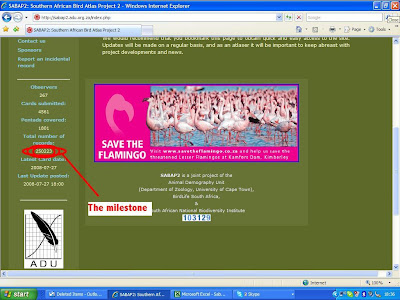Today, while atlasing pentad 3045_2650, towards the south east of Aliwal North, I had been very lucky to spot a new species for my year list - taking the total to 281. The last new addition to the year list had been a little more than a month ago on 08.05.2008. This new addition is somewhat of a rarity in our part of the country and unfortunately it had been too far off to take a photo.
A Black-chested Snake Eagle was the reason for my heart to skip a beat or two. It was sitting in a large willow tree near the edge of a farm dam near the farmstead of Braamspruit. It was strange to observe this raptor here near a dam - but Roberts VII states that they sometimes take water monitors as prey. The sun was baking on the little rocky outcrop bordering the eastern side of the dam - and it may well have been that the eagle was looking around for a titbit seeking the warmth of the winter sun and letting down its guard for a second too long.
Two other "specials" for the afternoon were a pair of Grey Crowned Cranes and a Yellow-bellied Eremomela. The cranes were wading in the shallow, marshy end of a farm dam (with a lot of growth in the water) on the farm Lucerne. I spotted the eremomela flitting from low bush to low bush while I had been looking at a pair of Yellow Canaries through my binoculars. The eremomela showed so well and it was easy to positively identify it.
The total count for the afternoon was 44 species. Strangely enough - the eagle was the only raptor of the day. The area is normally frequented by Black-shouldered Kite, Greater and Rock Kestrel and Southern Pale Chanting Goshawk. I have observed an African Harrier-Hawk as well on previous surveys of the pentad. Some of the regulars were: Common Fiscal, Pied and Cape Glossy Starling, Cape and Southern Grey-headed Sparrow, Southern Masked and Cape Weaver, Helmeted Guineafowl and the Egyptian Geese that are nearly always present in the largest part of the district. A flock of Red-billed Quealea (about 60-80 birds) were seen as well.
My total score of species for this specific pentad is 107. Today's count is till to be added. I'll update the score as soon as I get back the results of today's survey from the ADU by early tomorrow. (After the update on 14.06.2008, the score is 111 species with one unvetted record.)















 We could watch it for quite a long time where it was actively hunting for water insects from it’s perch at a farm dam. The first hour of the survey added 36 species, in the second another 9 was added and the third only added 4 new species to the survey list. A single Greater Kestrel and three Black-shouldered Kites hunting together over a stretch of grassveld were the only raptors seen.
We could watch it for quite a long time where it was actively hunting for water insects from it’s perch at a farm dam. The first hour of the survey added 36 species, in the second another 9 was added and the third only added 4 new species to the survey list. A single Greater Kestrel and three Black-shouldered Kites hunting together over a stretch of grassveld were the only raptors seen. Unfortunately it only gave me a few seconds to take a picture before it flew off. It nevertheless was a great sighting. The tally for the pentad grew from 63 to 75 unique species – again despite the fact that is winter and activity amongst birds are generally lower in winter. I counted 45 species in total in the 2 hours of surveying the pentad. Except for the Lanner Falcon, I saw a Southern Pale Chanting Goshawk on two separate occasions and a single Black-headed Heron (the only one for the day).
Unfortunately it only gave me a few seconds to take a picture before it flew off. It nevertheless was a great sighting. The tally for the pentad grew from 63 to 75 unique species – again despite the fact that is winter and activity amongst birds are generally lower in winter. I counted 45 species in total in the 2 hours of surveying the pentad. Except for the Lanner Falcon, I saw a Southern Pale Chanting Goshawk on two separate occasions and a single Black-headed Heron (the only one for the day).










